School of Public Health Research Project: India Maternal Care Policies
VerifiedAdded on 2023/06/04
|43
|11762
|196
Report
AI Summary
This research project is a comprehensive analysis of policies designed to promote child and maternal care in India, focusing on a systematic review of existing literature. The study investigates the impact of various initiatives, including the Safe Motherhood Scheme (Janani Suraksha Yojna) and the National Rural Health Mission (NRHM), on key health indicators such as maternal mortality ratio (MMR) and institutional delivery rates. The methodology involves a PRISMA guideline-guided search across databases like CINAHL, PubMed, and Medline, followed by thematic analysis of research findings. The results highlight the impact of programs on improving institutional delivery rates but also reveal shortcomings in antenatal care quality and program design. The analysis identifies four key themes: policies on MMR and institutional delivery, reducing financial barriers, addressing inequities, and improving antenatal care access. The report concludes with recommendations to remodel program designs, improve healthcare professional recruitment, and address the identified barriers to improve maternal and antenatal care outcomes. The study underscores the need for a more patient-centered approach and equitable distribution of healthcare resources to achieve desired maternal health targets in India.
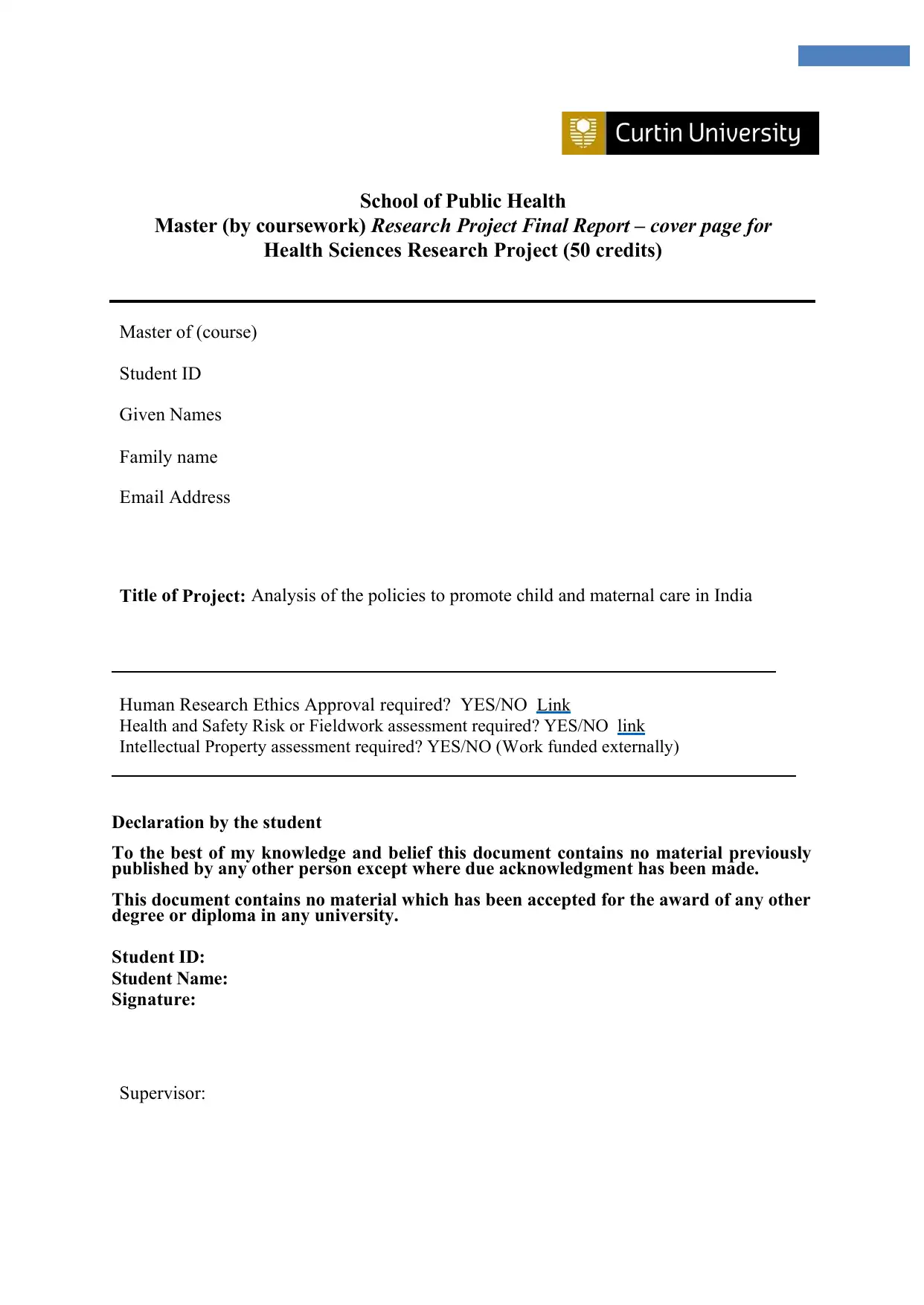
School of Public Health
Master (by coursework) Research Project Final Report – cover page for
Health Sciences Research Project (50 credits)
Master of (course)
Student ID
Given Names
Family name
Email Address
Title of Project: Analysis of the policies to promote child and maternal care in India
Human Research Ethics Approval required? YES/NO Link
Health and Safety Risk or Fieldwork assessment required? YES/NO link
Intellectual Property assessment required? YES/NO (Work funded externally)
Declaration by the student
To the best of my knowledge and belief this document contains no material previously
published by any other person except where due acknowledgment has been made.
This document contains no material which has been accepted for the award of any other
degree or diploma in any university.
Student ID:
Student Name:
Signature:
Supervisor:
Master (by coursework) Research Project Final Report – cover page for
Health Sciences Research Project (50 credits)
Master of (course)
Student ID
Given Names
Family name
Email Address
Title of Project: Analysis of the policies to promote child and maternal care in India
Human Research Ethics Approval required? YES/NO Link
Health and Safety Risk or Fieldwork assessment required? YES/NO link
Intellectual Property assessment required? YES/NO (Work funded externally)
Declaration by the student
To the best of my knowledge and belief this document contains no material previously
published by any other person except where due acknowledgment has been made.
This document contains no material which has been accepted for the award of any other
degree or diploma in any university.
Student ID:
Student Name:
Signature:
Supervisor:
Paraphrase This Document
Need a fresh take? Get an instant paraphrase of this document with our AI Paraphraser
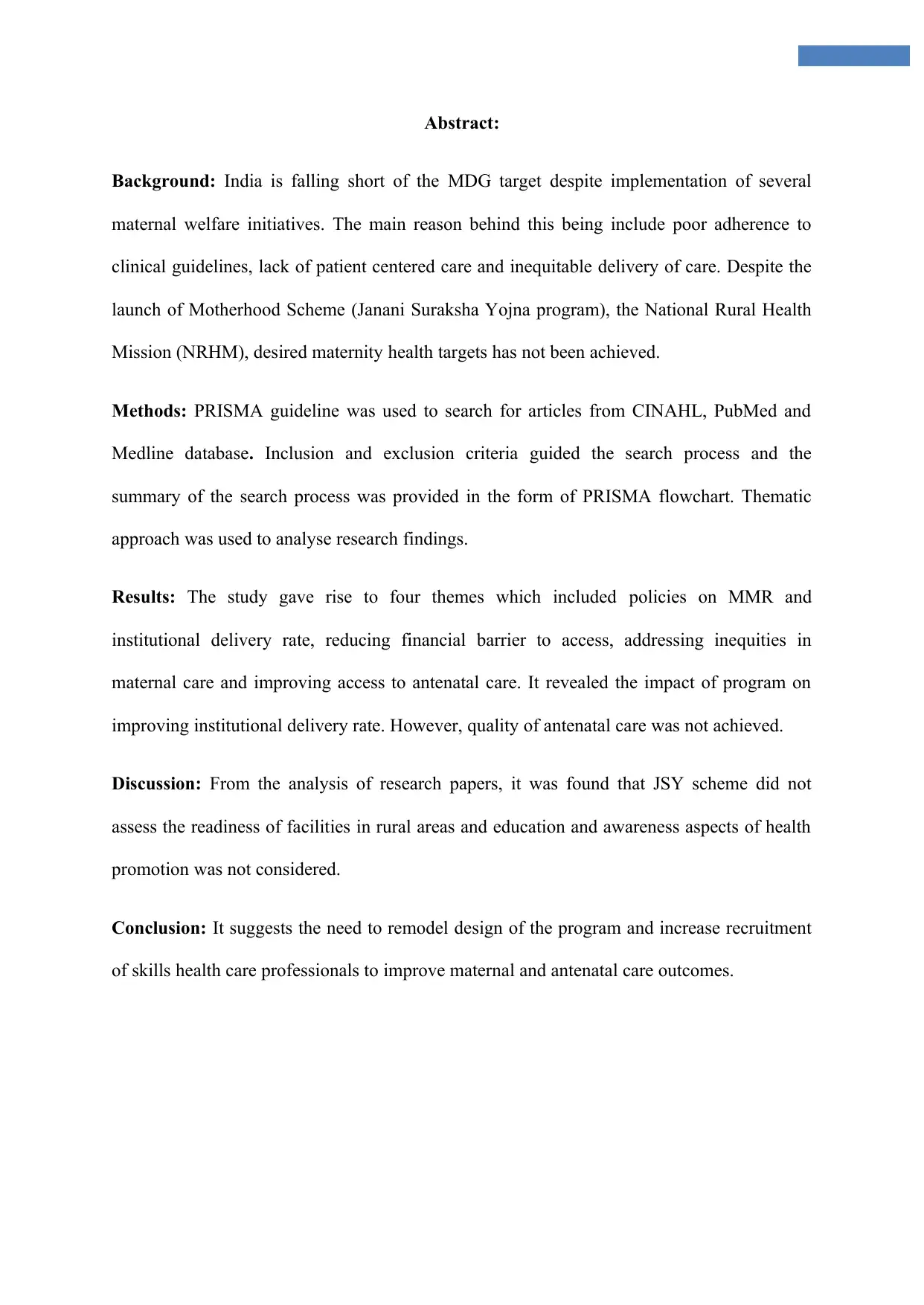
Abstract:
Background: India is falling short of the MDG target despite implementation of several
maternal welfare initiatives. The main reason behind this being include poor adherence to
clinical guidelines, lack of patient centered care and inequitable delivery of care. Despite the
launch of Motherhood Scheme (Janani Suraksha Yojna program), the National Rural Health
Mission (NRHM), desired maternity health targets has not been achieved.
Methods: PRISMA guideline was used to search for articles from CINAHL, PubMed and
Medline database. Inclusion and exclusion criteria guided the search process and the
summary of the search process was provided in the form of PRISMA flowchart. Thematic
approach was used to analyse research findings.
Results: The study gave rise to four themes which included policies on MMR and
institutional delivery rate, reducing financial barrier to access, addressing inequities in
maternal care and improving access to antenatal care. It revealed the impact of program on
improving institutional delivery rate. However, quality of antenatal care was not achieved.
Discussion: From the analysis of research papers, it was found that JSY scheme did not
assess the readiness of facilities in rural areas and education and awareness aspects of health
promotion was not considered.
Conclusion: It suggests the need to remodel design of the program and increase recruitment
of skills health care professionals to improve maternal and antenatal care outcomes.
Background: India is falling short of the MDG target despite implementation of several
maternal welfare initiatives. The main reason behind this being include poor adherence to
clinical guidelines, lack of patient centered care and inequitable delivery of care. Despite the
launch of Motherhood Scheme (Janani Suraksha Yojna program), the National Rural Health
Mission (NRHM), desired maternity health targets has not been achieved.
Methods: PRISMA guideline was used to search for articles from CINAHL, PubMed and
Medline database. Inclusion and exclusion criteria guided the search process and the
summary of the search process was provided in the form of PRISMA flowchart. Thematic
approach was used to analyse research findings.
Results: The study gave rise to four themes which included policies on MMR and
institutional delivery rate, reducing financial barrier to access, addressing inequities in
maternal care and improving access to antenatal care. It revealed the impact of program on
improving institutional delivery rate. However, quality of antenatal care was not achieved.
Discussion: From the analysis of research papers, it was found that JSY scheme did not
assess the readiness of facilities in rural areas and education and awareness aspects of health
promotion was not considered.
Conclusion: It suggests the need to remodel design of the program and increase recruitment
of skills health care professionals to improve maternal and antenatal care outcomes.
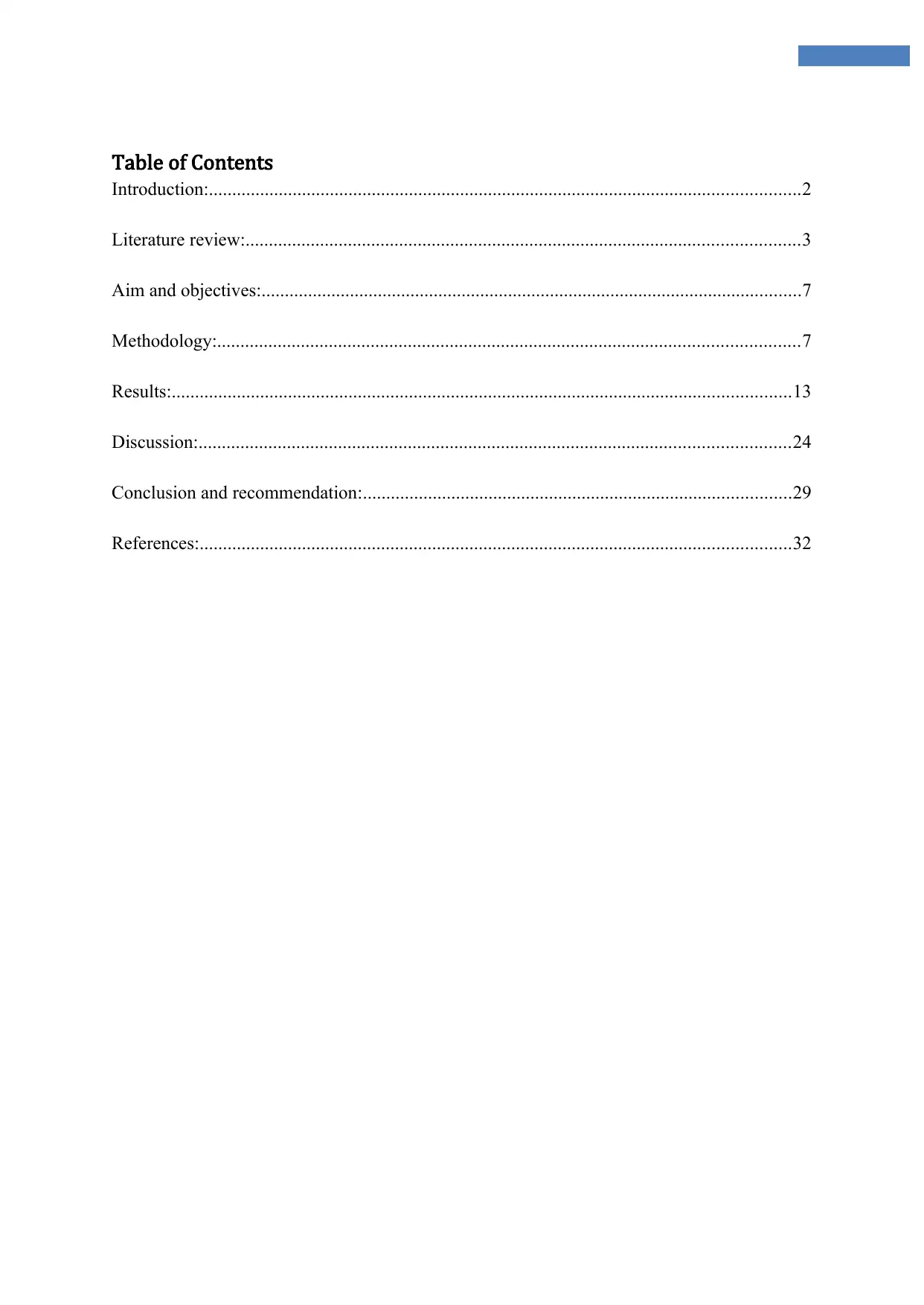
Table of Contents
Introduction:...............................................................................................................................2
Literature review:.......................................................................................................................3
Aim and objectives:....................................................................................................................7
Methodology:.............................................................................................................................7
Results:.....................................................................................................................................13
Discussion:...............................................................................................................................24
Conclusion and recommendation:............................................................................................29
References:...............................................................................................................................32
Introduction:...............................................................................................................................2
Literature review:.......................................................................................................................3
Aim and objectives:....................................................................................................................7
Methodology:.............................................................................................................................7
Results:.....................................................................................................................................13
Discussion:...............................................................................................................................24
Conclusion and recommendation:............................................................................................29
References:...............................................................................................................................32
⊘ This is a preview!⊘
Do you want full access?
Subscribe today to unlock all pages.

Trusted by 1+ million students worldwide
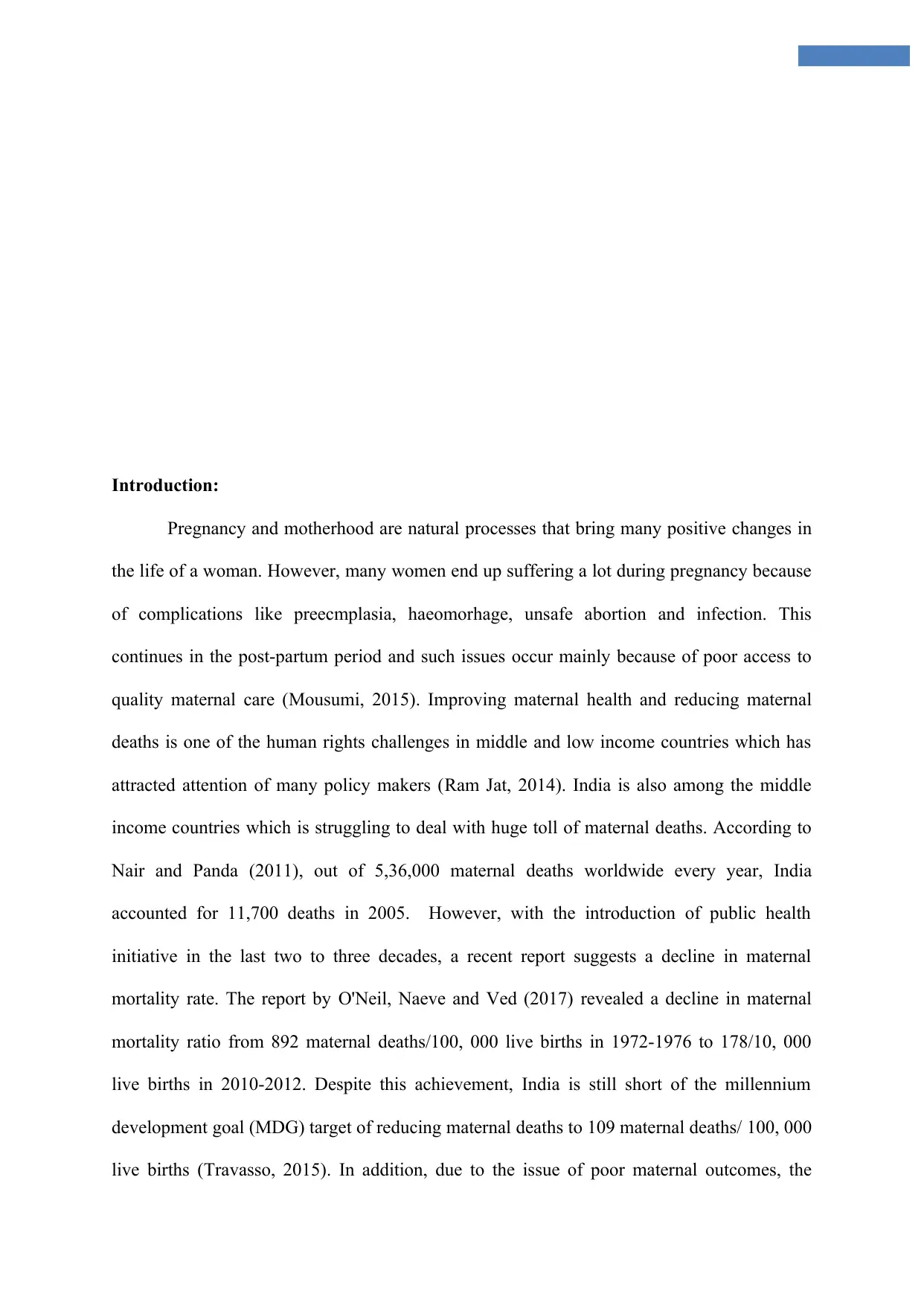
Introduction:
Pregnancy and motherhood are natural processes that bring many positive changes in
the life of a woman. However, many women end up suffering a lot during pregnancy because
of complications like preecmplasia, haeomorhage, unsafe abortion and infection. This
continues in the post-partum period and such issues occur mainly because of poor access to
quality maternal care (Mousumi, 2015). Improving maternal health and reducing maternal
deaths is one of the human rights challenges in middle and low income countries which has
attracted attention of many policy makers (Ram Jat, 2014). India is also among the middle
income countries which is struggling to deal with huge toll of maternal deaths. According to
Nair and Panda (2011), out of 5,36,000 maternal deaths worldwide every year, India
accounted for 11,700 deaths in 2005. However, with the introduction of public health
initiative in the last two to three decades, a recent report suggests a decline in maternal
mortality rate. The report by O'Neil, Naeve and Ved (2017) revealed a decline in maternal
mortality ratio from 892 maternal deaths/100, 000 live births in 1972-1976 to 178/10, 000
live births in 2010-2012. Despite this achievement, India is still short of the millennium
development goal (MDG) target of reducing maternal deaths to 109 maternal deaths/ 100, 000
live births (Travasso, 2015). In addition, due to the issue of poor maternal outcomes, the
Pregnancy and motherhood are natural processes that bring many positive changes in
the life of a woman. However, many women end up suffering a lot during pregnancy because
of complications like preecmplasia, haeomorhage, unsafe abortion and infection. This
continues in the post-partum period and such issues occur mainly because of poor access to
quality maternal care (Mousumi, 2015). Improving maternal health and reducing maternal
deaths is one of the human rights challenges in middle and low income countries which has
attracted attention of many policy makers (Ram Jat, 2014). India is also among the middle
income countries which is struggling to deal with huge toll of maternal deaths. According to
Nair and Panda (2011), out of 5,36,000 maternal deaths worldwide every year, India
accounted for 11,700 deaths in 2005. However, with the introduction of public health
initiative in the last two to three decades, a recent report suggests a decline in maternal
mortality rate. The report by O'Neil, Naeve and Ved (2017) revealed a decline in maternal
mortality ratio from 892 maternal deaths/100, 000 live births in 1972-1976 to 178/10, 000
live births in 2010-2012. Despite this achievement, India is still short of the millennium
development goal (MDG) target of reducing maternal deaths to 109 maternal deaths/ 100, 000
live births (Travasso, 2015). In addition, due to the issue of poor maternal outcomes, the
Paraphrase This Document
Need a fresh take? Get an instant paraphrase of this document with our AI Paraphraser
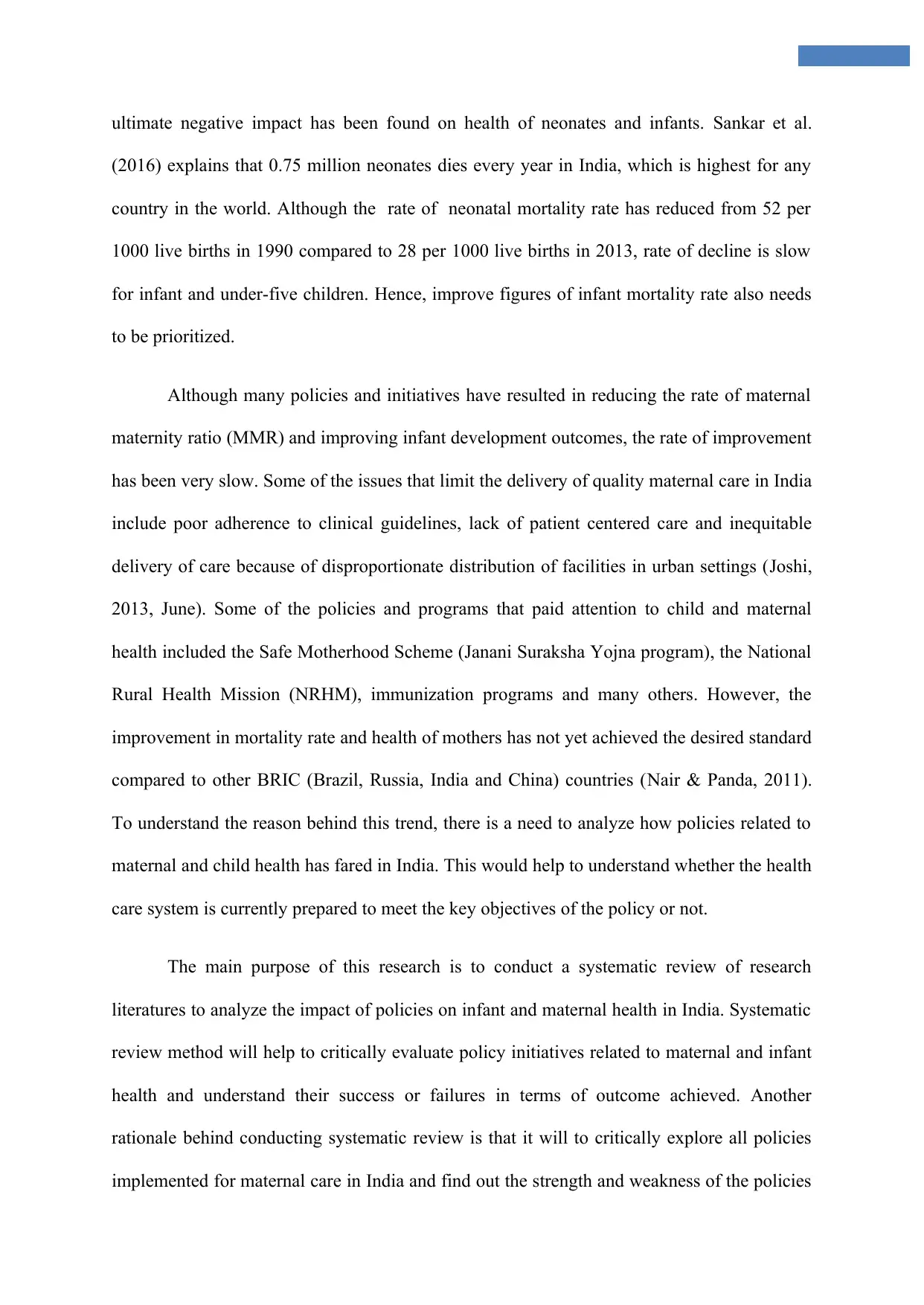
ultimate negative impact has been found on health of neonates and infants. Sankar et al.
(2016) explains that 0.75 million neonates dies every year in India, which is highest for any
country in the world. Although the rate of neonatal mortality rate has reduced from 52 per
1000 live births in 1990 compared to 28 per 1000 live births in 2013, rate of decline is slow
for infant and under-five children. Hence, improve figures of infant mortality rate also needs
to be prioritized.
Although many policies and initiatives have resulted in reducing the rate of maternal
maternity ratio (MMR) and improving infant development outcomes, the rate of improvement
has been very slow. Some of the issues that limit the delivery of quality maternal care in India
include poor adherence to clinical guidelines, lack of patient centered care and inequitable
delivery of care because of disproportionate distribution of facilities in urban settings (Joshi,
2013, June). Some of the policies and programs that paid attention to child and maternal
health included the Safe Motherhood Scheme (Janani Suraksha Yojna program), the National
Rural Health Mission (NRHM), immunization programs and many others. However, the
improvement in mortality rate and health of mothers has not yet achieved the desired standard
compared to other BRIC (Brazil, Russia, India and China) countries (Nair & Panda, 2011).
To understand the reason behind this trend, there is a need to analyze how policies related to
maternal and child health has fared in India. This would help to understand whether the health
care system is currently prepared to meet the key objectives of the policy or not.
The main purpose of this research is to conduct a systematic review of research
literatures to analyze the impact of policies on infant and maternal health in India. Systematic
review method will help to critically evaluate policy initiatives related to maternal and infant
health and understand their success or failures in terms of outcome achieved. Another
rationale behind conducting systematic review is that it will to critically explore all policies
implemented for maternal care in India and find out the strength and weakness of the policies
(2016) explains that 0.75 million neonates dies every year in India, which is highest for any
country in the world. Although the rate of neonatal mortality rate has reduced from 52 per
1000 live births in 1990 compared to 28 per 1000 live births in 2013, rate of decline is slow
for infant and under-five children. Hence, improve figures of infant mortality rate also needs
to be prioritized.
Although many policies and initiatives have resulted in reducing the rate of maternal
maternity ratio (MMR) and improving infant development outcomes, the rate of improvement
has been very slow. Some of the issues that limit the delivery of quality maternal care in India
include poor adherence to clinical guidelines, lack of patient centered care and inequitable
delivery of care because of disproportionate distribution of facilities in urban settings (Joshi,
2013, June). Some of the policies and programs that paid attention to child and maternal
health included the Safe Motherhood Scheme (Janani Suraksha Yojna program), the National
Rural Health Mission (NRHM), immunization programs and many others. However, the
improvement in mortality rate and health of mothers has not yet achieved the desired standard
compared to other BRIC (Brazil, Russia, India and China) countries (Nair & Panda, 2011).
To understand the reason behind this trend, there is a need to analyze how policies related to
maternal and child health has fared in India. This would help to understand whether the health
care system is currently prepared to meet the key objectives of the policy or not.
The main purpose of this research is to conduct a systematic review of research
literatures to analyze the impact of policies on infant and maternal health in India. Systematic
review method will help to critically evaluate policy initiatives related to maternal and infant
health and understand their success or failures in terms of outcome achieved. Another
rationale behind conducting systematic review is that it will to critically explore all policies
implemented for maternal care in India and find out the strength and weakness of the policies
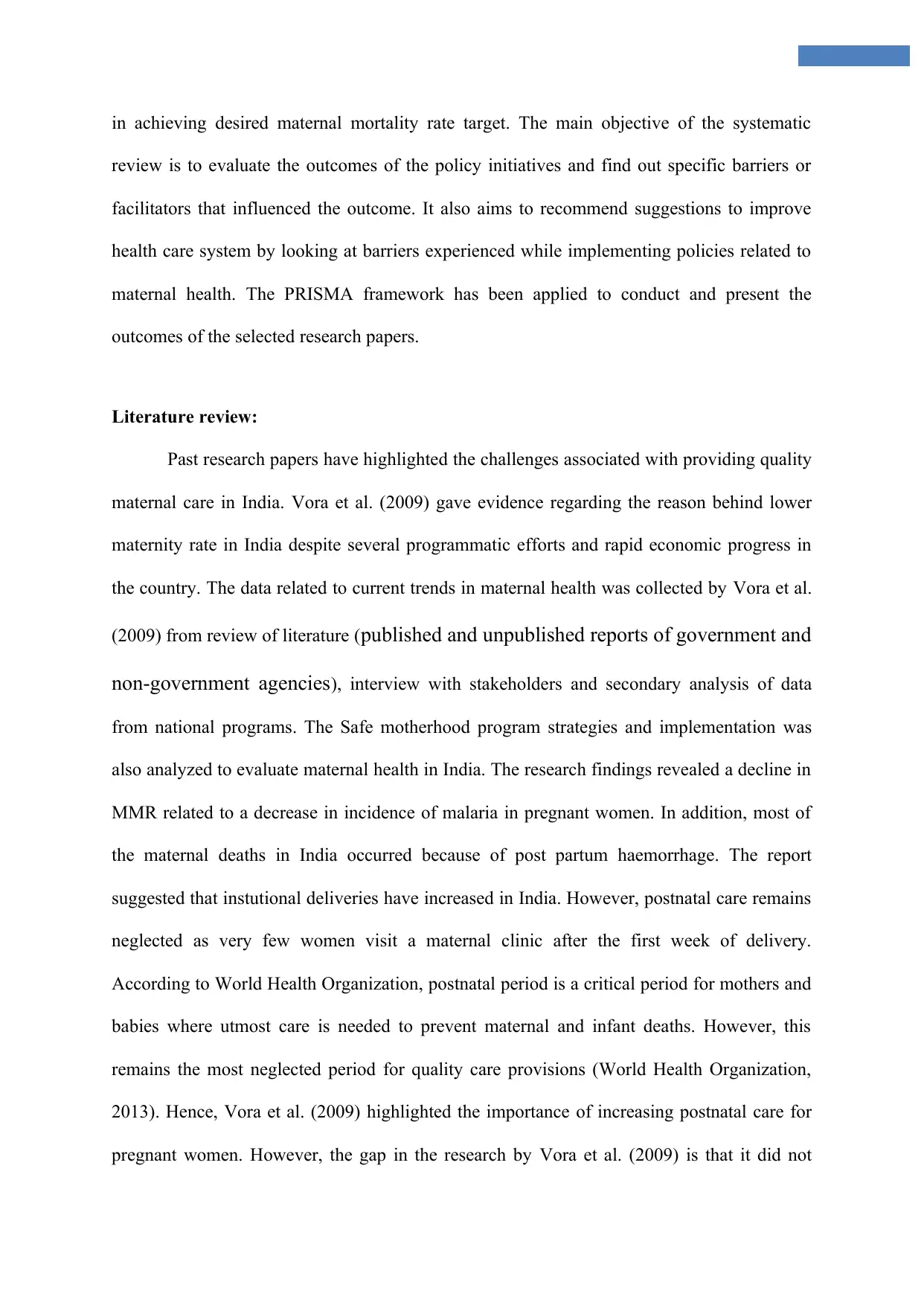
in achieving desired maternal mortality rate target. The main objective of the systematic
review is to evaluate the outcomes of the policy initiatives and find out specific barriers or
facilitators that influenced the outcome. It also aims to recommend suggestions to improve
health care system by looking at barriers experienced while implementing policies related to
maternal health. The PRISMA framework has been applied to conduct and present the
outcomes of the selected research papers.
Literature review:
Past research papers have highlighted the challenges associated with providing quality
maternal care in India. Vora et al. (2009) gave evidence regarding the reason behind lower
maternity rate in India despite several programmatic efforts and rapid economic progress in
the country. The data related to current trends in maternal health was collected by Vora et al.
(2009) from review of literature (published and unpublished reports of government and
non-government agencies), interview with stakeholders and secondary analysis of data
from national programs. The Safe motherhood program strategies and implementation was
also analyzed to evaluate maternal health in India. The research findings revealed a decline in
MMR related to a decrease in incidence of malaria in pregnant women. In addition, most of
the maternal deaths in India occurred because of post partum haemorrhage. The report
suggested that instutional deliveries have increased in India. However, postnatal care remains
neglected as very few women visit a maternal clinic after the first week of delivery.
According to World Health Organization, postnatal period is a critical period for mothers and
babies where utmost care is needed to prevent maternal and infant deaths. However, this
remains the most neglected period for quality care provisions (World Health Organization,
2013). Hence, Vora et al. (2009) highlighted the importance of increasing postnatal care for
pregnant women. However, the gap in the research by Vora et al. (2009) is that it did not
review is to evaluate the outcomes of the policy initiatives and find out specific barriers or
facilitators that influenced the outcome. It also aims to recommend suggestions to improve
health care system by looking at barriers experienced while implementing policies related to
maternal health. The PRISMA framework has been applied to conduct and present the
outcomes of the selected research papers.
Literature review:
Past research papers have highlighted the challenges associated with providing quality
maternal care in India. Vora et al. (2009) gave evidence regarding the reason behind lower
maternity rate in India despite several programmatic efforts and rapid economic progress in
the country. The data related to current trends in maternal health was collected by Vora et al.
(2009) from review of literature (published and unpublished reports of government and
non-government agencies), interview with stakeholders and secondary analysis of data
from national programs. The Safe motherhood program strategies and implementation was
also analyzed to evaluate maternal health in India. The research findings revealed a decline in
MMR related to a decrease in incidence of malaria in pregnant women. In addition, most of
the maternal deaths in India occurred because of post partum haemorrhage. The report
suggested that instutional deliveries have increased in India. However, postnatal care remains
neglected as very few women visit a maternal clinic after the first week of delivery.
According to World Health Organization, postnatal period is a critical period for mothers and
babies where utmost care is needed to prevent maternal and infant deaths. However, this
remains the most neglected period for quality care provisions (World Health Organization,
2013). Hence, Vora et al. (2009) highlighted the importance of increasing postnatal care for
pregnant women. However, the gap in the research by Vora et al. (2009) is that it did not
⊘ This is a preview!⊘
Do you want full access?
Subscribe today to unlock all pages.

Trusted by 1+ million students worldwide
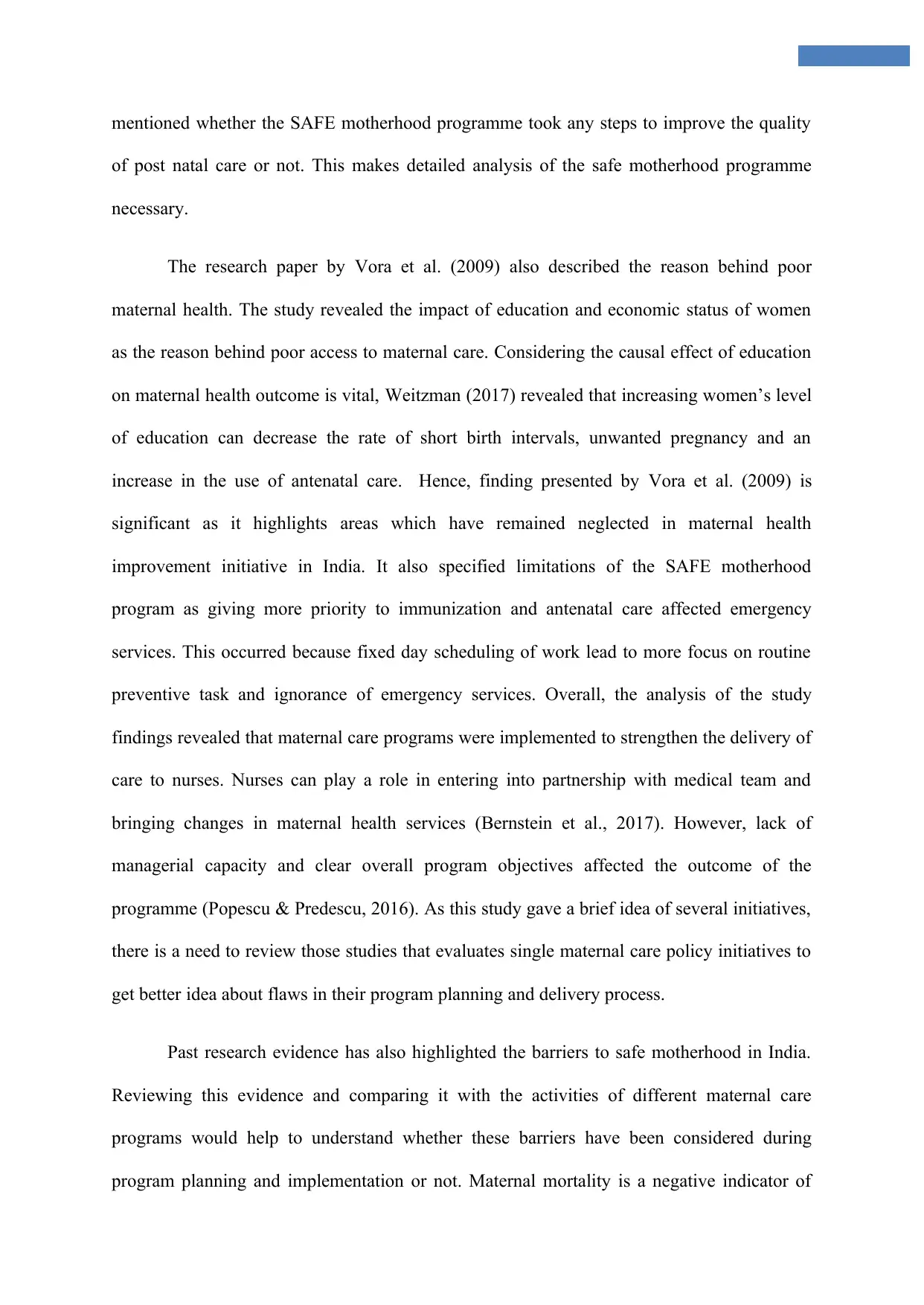
mentioned whether the SAFE motherhood programme took any steps to improve the quality
of post natal care or not. This makes detailed analysis of the safe motherhood programme
necessary.
The research paper by Vora et al. (2009) also described the reason behind poor
maternal health. The study revealed the impact of education and economic status of women
as the reason behind poor access to maternal care. Considering the causal effect of education
on maternal health outcome is vital, Weitzman (2017) revealed that increasing women’s level
of education can decrease the rate of short birth intervals, unwanted pregnancy and an
increase in the use of antenatal care. Hence, finding presented by Vora et al. (2009) is
significant as it highlights areas which have remained neglected in maternal health
improvement initiative in India. It also specified limitations of the SAFE motherhood
program as giving more priority to immunization and antenatal care affected emergency
services. This occurred because fixed day scheduling of work lead to more focus on routine
preventive task and ignorance of emergency services. Overall, the analysis of the study
findings revealed that maternal care programs were implemented to strengthen the delivery of
care to nurses. Nurses can play a role in entering into partnership with medical team and
bringing changes in maternal health services (Bernstein et al., 2017). However, lack of
managerial capacity and clear overall program objectives affected the outcome of the
programme (Popescu & Predescu, 2016). As this study gave a brief idea of several initiatives,
there is a need to review those studies that evaluates single maternal care policy initiatives to
get better idea about flaws in their program planning and delivery process.
Past research evidence has also highlighted the barriers to safe motherhood in India.
Reviewing this evidence and comparing it with the activities of different maternal care
programs would help to understand whether these barriers have been considered during
program planning and implementation or not. Maternal mortality is a negative indicator of
of post natal care or not. This makes detailed analysis of the safe motherhood programme
necessary.
The research paper by Vora et al. (2009) also described the reason behind poor
maternal health. The study revealed the impact of education and economic status of women
as the reason behind poor access to maternal care. Considering the causal effect of education
on maternal health outcome is vital, Weitzman (2017) revealed that increasing women’s level
of education can decrease the rate of short birth intervals, unwanted pregnancy and an
increase in the use of antenatal care. Hence, finding presented by Vora et al. (2009) is
significant as it highlights areas which have remained neglected in maternal health
improvement initiative in India. It also specified limitations of the SAFE motherhood
program as giving more priority to immunization and antenatal care affected emergency
services. This occurred because fixed day scheduling of work lead to more focus on routine
preventive task and ignorance of emergency services. Overall, the analysis of the study
findings revealed that maternal care programs were implemented to strengthen the delivery of
care to nurses. Nurses can play a role in entering into partnership with medical team and
bringing changes in maternal health services (Bernstein et al., 2017). However, lack of
managerial capacity and clear overall program objectives affected the outcome of the
programme (Popescu & Predescu, 2016). As this study gave a brief idea of several initiatives,
there is a need to review those studies that evaluates single maternal care policy initiatives to
get better idea about flaws in their program planning and delivery process.
Past research evidence has also highlighted the barriers to safe motherhood in India.
Reviewing this evidence and comparing it with the activities of different maternal care
programs would help to understand whether these barriers have been considered during
program planning and implementation or not. Maternal mortality is a negative indicator of
Paraphrase This Document
Need a fresh take? Get an instant paraphrase of this document with our AI Paraphraser
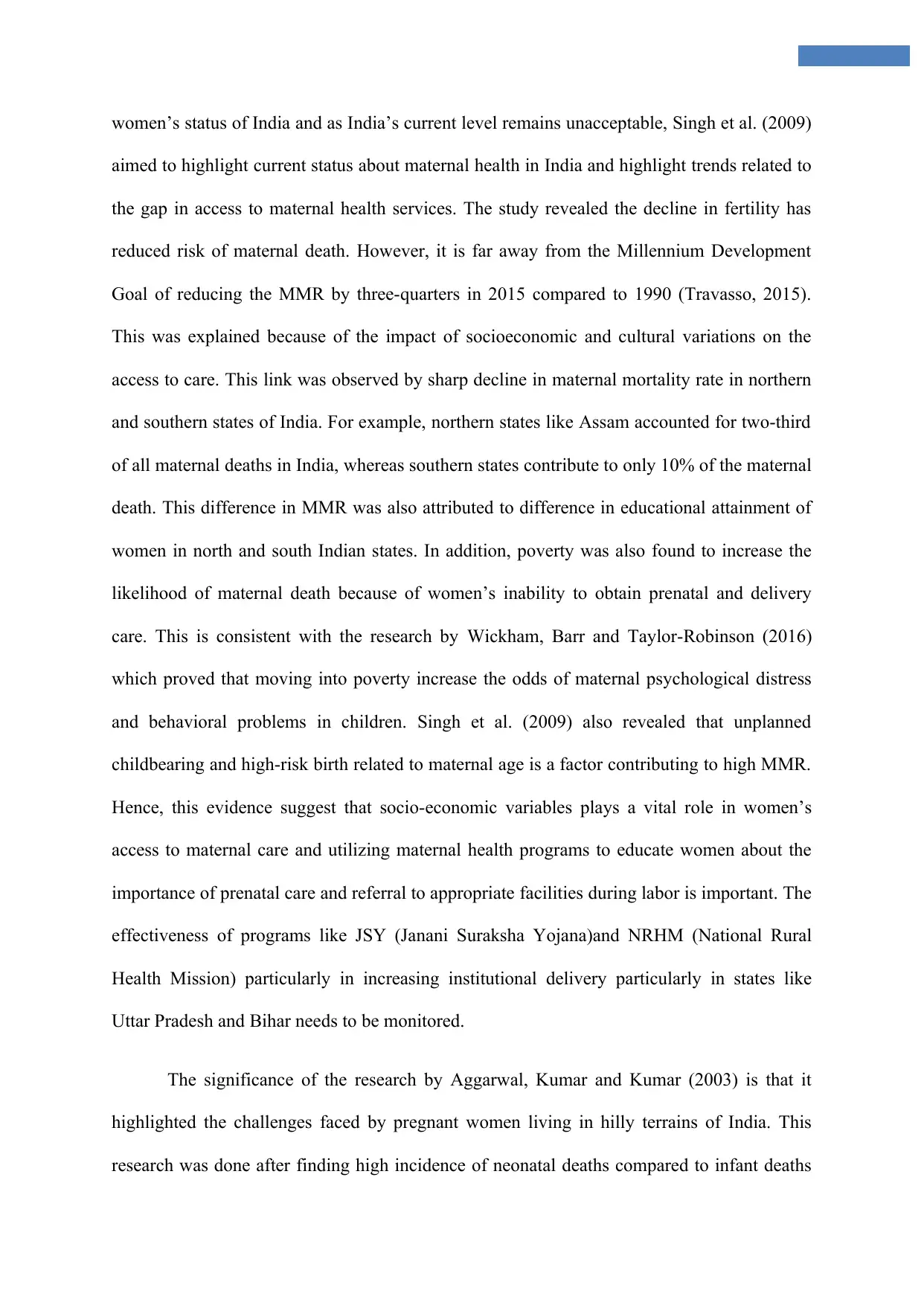
women’s status of India and as India’s current level remains unacceptable, Singh et al. (2009)
aimed to highlight current status about maternal health in India and highlight trends related to
the gap in access to maternal health services. The study revealed the decline in fertility has
reduced risk of maternal death. However, it is far away from the Millennium Development
Goal of reducing the MMR by three-quarters in 2015 compared to 1990 (Travasso, 2015).
This was explained because of the impact of socioeconomic and cultural variations on the
access to care. This link was observed by sharp decline in maternal mortality rate in northern
and southern states of India. For example, northern states like Assam accounted for two-third
of all maternal deaths in India, whereas southern states contribute to only 10% of the maternal
death. This difference in MMR was also attributed to difference in educational attainment of
women in north and south Indian states. In addition, poverty was also found to increase the
likelihood of maternal death because of women’s inability to obtain prenatal and delivery
care. This is consistent with the research by Wickham, Barr and Taylor-Robinson (2016)
which proved that moving into poverty increase the odds of maternal psychological distress
and behavioral problems in children. Singh et al. (2009) also revealed that unplanned
childbearing and high-risk birth related to maternal age is a factor contributing to high MMR.
Hence, this evidence suggest that socio-economic variables plays a vital role in women’s
access to maternal care and utilizing maternal health programs to educate women about the
importance of prenatal care and referral to appropriate facilities during labor is important. The
effectiveness of programs like JSY (Janani Suraksha Yojana)and NRHM (National Rural
Health Mission) particularly in increasing institutional delivery particularly in states like
Uttar Pradesh and Bihar needs to be monitored.
The significance of the research by Aggarwal, Kumar and Kumar (2003) is that it
highlighted the challenges faced by pregnant women living in hilly terrains of India. This
research was done after finding high incidence of neonatal deaths compared to infant deaths
aimed to highlight current status about maternal health in India and highlight trends related to
the gap in access to maternal health services. The study revealed the decline in fertility has
reduced risk of maternal death. However, it is far away from the Millennium Development
Goal of reducing the MMR by three-quarters in 2015 compared to 1990 (Travasso, 2015).
This was explained because of the impact of socioeconomic and cultural variations on the
access to care. This link was observed by sharp decline in maternal mortality rate in northern
and southern states of India. For example, northern states like Assam accounted for two-third
of all maternal deaths in India, whereas southern states contribute to only 10% of the maternal
death. This difference in MMR was also attributed to difference in educational attainment of
women in north and south Indian states. In addition, poverty was also found to increase the
likelihood of maternal death because of women’s inability to obtain prenatal and delivery
care. This is consistent with the research by Wickham, Barr and Taylor-Robinson (2016)
which proved that moving into poverty increase the odds of maternal psychological distress
and behavioral problems in children. Singh et al. (2009) also revealed that unplanned
childbearing and high-risk birth related to maternal age is a factor contributing to high MMR.
Hence, this evidence suggest that socio-economic variables plays a vital role in women’s
access to maternal care and utilizing maternal health programs to educate women about the
importance of prenatal care and referral to appropriate facilities during labor is important. The
effectiveness of programs like JSY (Janani Suraksha Yojana)and NRHM (National Rural
Health Mission) particularly in increasing institutional delivery particularly in states like
Uttar Pradesh and Bihar needs to be monitored.
The significance of the research by Aggarwal, Kumar and Kumar (2003) is that it
highlighted the challenges faced by pregnant women living in hilly terrains of India. This
research was done after finding high incidence of neonatal deaths compared to infant deaths
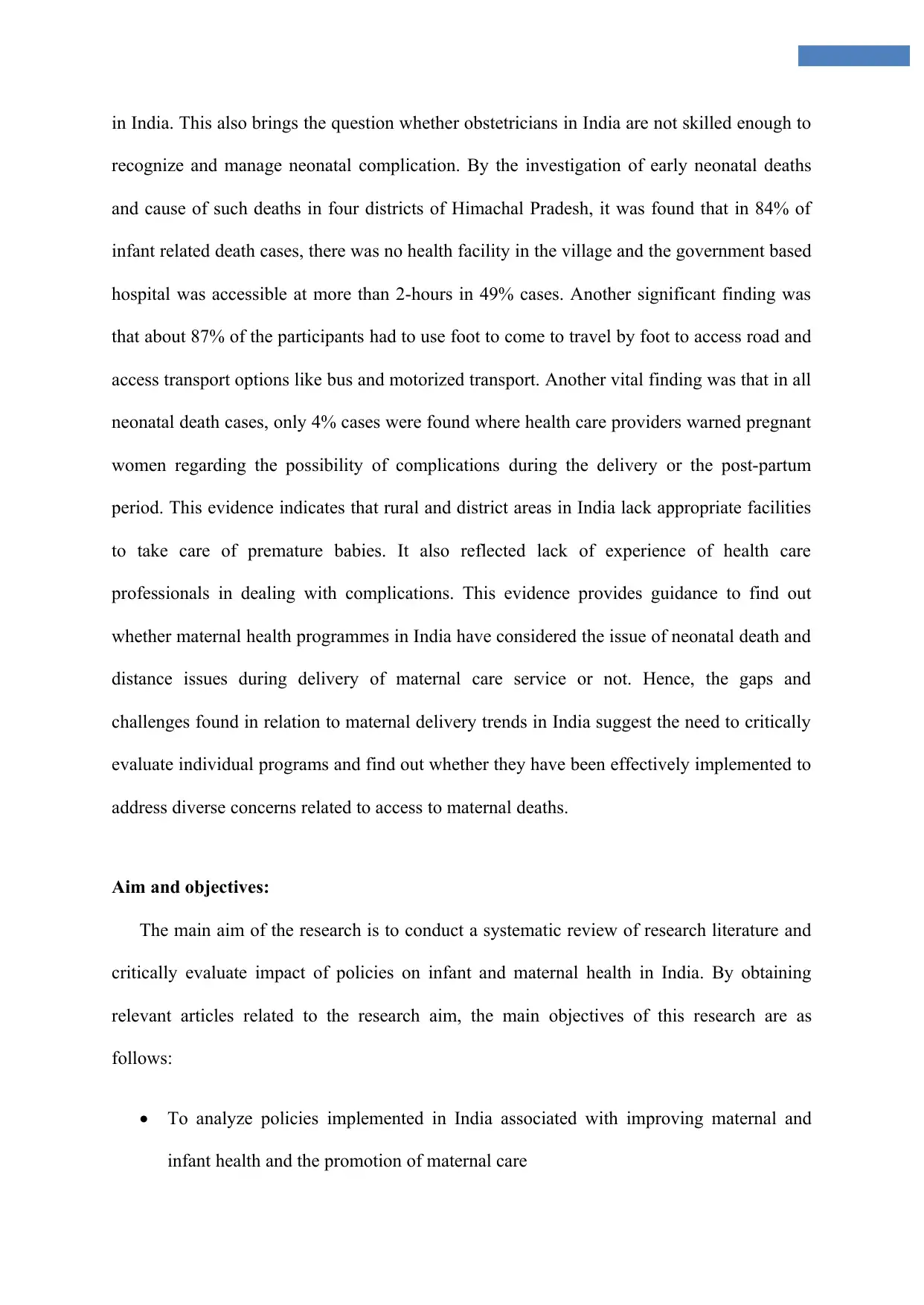
in India. This also brings the question whether obstetricians in India are not skilled enough to
recognize and manage neonatal complication. By the investigation of early neonatal deaths
and cause of such deaths in four districts of Himachal Pradesh, it was found that in 84% of
infant related death cases, there was no health facility in the village and the government based
hospital was accessible at more than 2-hours in 49% cases. Another significant finding was
that about 87% of the participants had to use foot to come to travel by foot to access road and
access transport options like bus and motorized transport. Another vital finding was that in all
neonatal death cases, only 4% cases were found where health care providers warned pregnant
women regarding the possibility of complications during the delivery or the post-partum
period. This evidence indicates that rural and district areas in India lack appropriate facilities
to take care of premature babies. It also reflected lack of experience of health care
professionals in dealing with complications. This evidence provides guidance to find out
whether maternal health programmes in India have considered the issue of neonatal death and
distance issues during delivery of maternal care service or not. Hence, the gaps and
challenges found in relation to maternal delivery trends in India suggest the need to critically
evaluate individual programs and find out whether they have been effectively implemented to
address diverse concerns related to access to maternal deaths.
Aim and objectives:
The main aim of the research is to conduct a systematic review of research literature and
critically evaluate impact of policies on infant and maternal health in India. By obtaining
relevant articles related to the research aim, the main objectives of this research are as
follows:
To analyze policies implemented in India associated with improving maternal and
infant health and the promotion of maternal care
recognize and manage neonatal complication. By the investigation of early neonatal deaths
and cause of such deaths in four districts of Himachal Pradesh, it was found that in 84% of
infant related death cases, there was no health facility in the village and the government based
hospital was accessible at more than 2-hours in 49% cases. Another significant finding was
that about 87% of the participants had to use foot to come to travel by foot to access road and
access transport options like bus and motorized transport. Another vital finding was that in all
neonatal death cases, only 4% cases were found where health care providers warned pregnant
women regarding the possibility of complications during the delivery or the post-partum
period. This evidence indicates that rural and district areas in India lack appropriate facilities
to take care of premature babies. It also reflected lack of experience of health care
professionals in dealing with complications. This evidence provides guidance to find out
whether maternal health programmes in India have considered the issue of neonatal death and
distance issues during delivery of maternal care service or not. Hence, the gaps and
challenges found in relation to maternal delivery trends in India suggest the need to critically
evaluate individual programs and find out whether they have been effectively implemented to
address diverse concerns related to access to maternal deaths.
Aim and objectives:
The main aim of the research is to conduct a systematic review of research literature and
critically evaluate impact of policies on infant and maternal health in India. By obtaining
relevant articles related to the research aim, the main objectives of this research are as
follows:
To analyze policies implemented in India associated with improving maternal and
infant health and the promotion of maternal care
⊘ This is a preview!⊘
Do you want full access?
Subscribe today to unlock all pages.

Trusted by 1+ million students worldwide
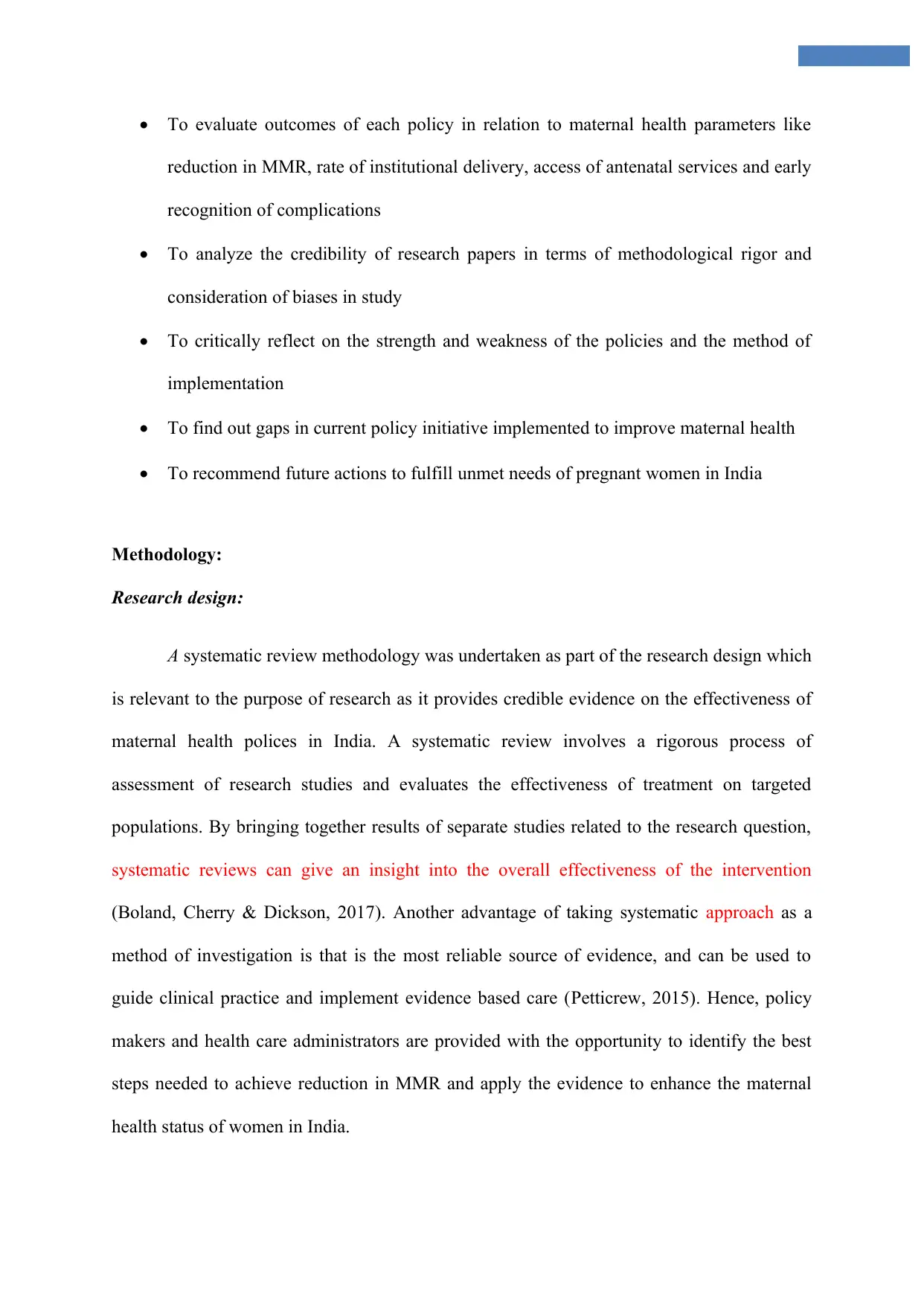
To evaluate outcomes of each policy in relation to maternal health parameters like
reduction in MMR, rate of institutional delivery, access of antenatal services and early
recognition of complications
To analyze the credibility of research papers in terms of methodological rigor and
consideration of biases in study
To critically reflect on the strength and weakness of the policies and the method of
implementation
To find out gaps in current policy initiative implemented to improve maternal health
To recommend future actions to fulfill unmet needs of pregnant women in India
Methodology:
Research design:
A systematic review methodology was undertaken as part of the research design which
is relevant to the purpose of research as it provides credible evidence on the effectiveness of
maternal health polices in India. A systematic review involves a rigorous process of
assessment of research studies and evaluates the effectiveness of treatment on targeted
populations. By bringing together results of separate studies related to the research question,
systematic reviews can give an insight into the overall effectiveness of the intervention
(Boland, Cherry & Dickson, 2017). Another advantage of taking systematic approach as a
method of investigation is that is the most reliable source of evidence, and can be used to
guide clinical practice and implement evidence based care (Petticrew, 2015). Hence, policy
makers and health care administrators are provided with the opportunity to identify the best
steps needed to achieve reduction in MMR and apply the evidence to enhance the maternal
health status of women in India.
reduction in MMR, rate of institutional delivery, access of antenatal services and early
recognition of complications
To analyze the credibility of research papers in terms of methodological rigor and
consideration of biases in study
To critically reflect on the strength and weakness of the policies and the method of
implementation
To find out gaps in current policy initiative implemented to improve maternal health
To recommend future actions to fulfill unmet needs of pregnant women in India
Methodology:
Research design:
A systematic review methodology was undertaken as part of the research design which
is relevant to the purpose of research as it provides credible evidence on the effectiveness of
maternal health polices in India. A systematic review involves a rigorous process of
assessment of research studies and evaluates the effectiveness of treatment on targeted
populations. By bringing together results of separate studies related to the research question,
systematic reviews can give an insight into the overall effectiveness of the intervention
(Boland, Cherry & Dickson, 2017). Another advantage of taking systematic approach as a
method of investigation is that is the most reliable source of evidence, and can be used to
guide clinical practice and implement evidence based care (Petticrew, 2015). Hence, policy
makers and health care administrators are provided with the opportunity to identify the best
steps needed to achieve reduction in MMR and apply the evidence to enhance the maternal
health status of women in India.
Paraphrase This Document
Need a fresh take? Get an instant paraphrase of this document with our AI Paraphraser
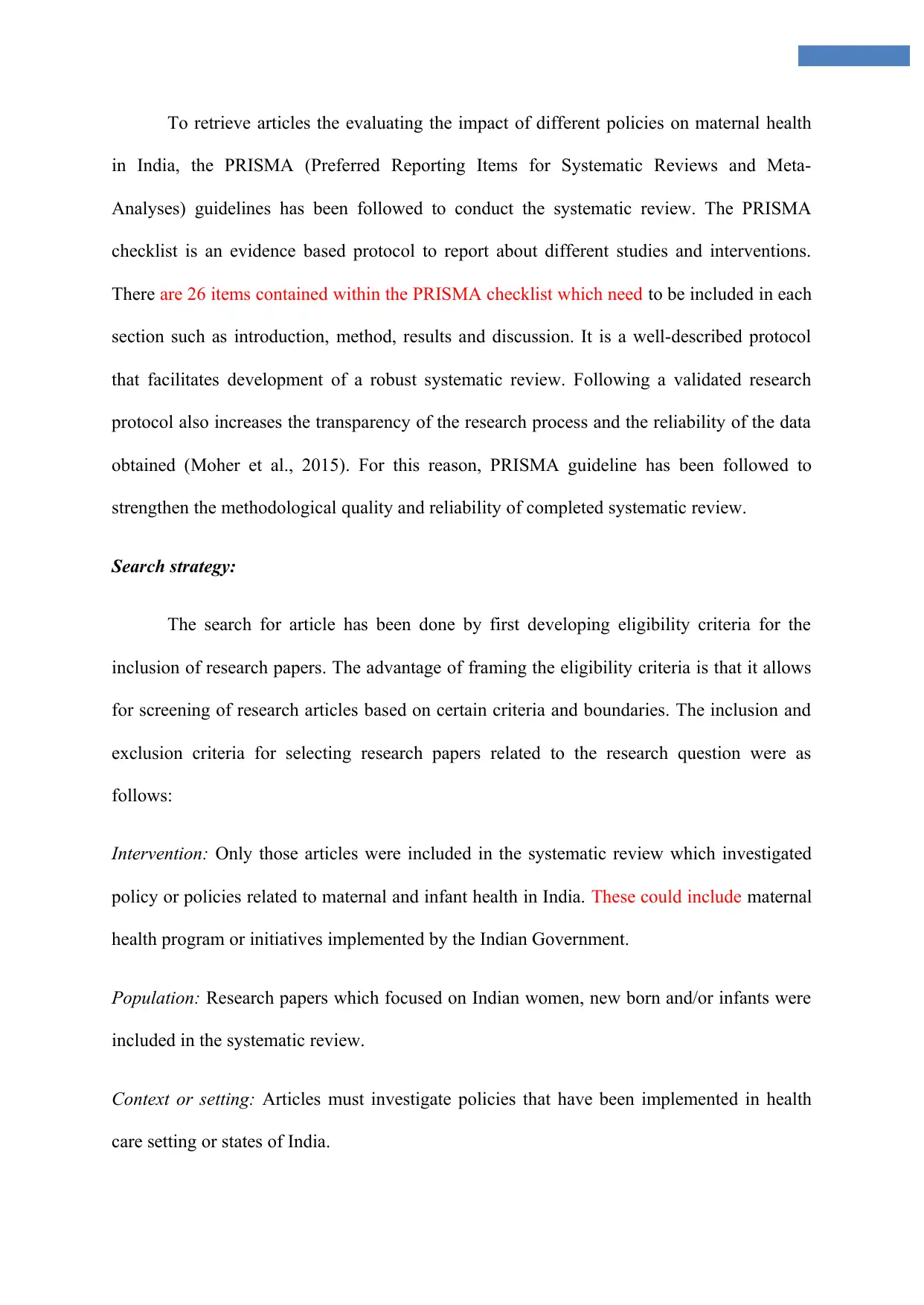
To retrieve articles the evaluating the impact of different policies on maternal health
in India, the PRISMA (Preferred Reporting Items for Systematic Reviews and Meta-
Analyses) guidelines has been followed to conduct the systematic review. The PRISMA
checklist is an evidence based protocol to report about different studies and interventions.
There are 26 items contained within the PRISMA checklist which need to be included in each
section such as introduction, method, results and discussion. It is a well-described protocol
that facilitates development of a robust systematic review. Following a validated research
protocol also increases the transparency of the research process and the reliability of the data
obtained (Moher et al., 2015). For this reason, PRISMA guideline has been followed to
strengthen the methodological quality and reliability of completed systematic review.
Search strategy:
The search for article has been done by first developing eligibility criteria for the
inclusion of research papers. The advantage of framing the eligibility criteria is that it allows
for screening of research articles based on certain criteria and boundaries. The inclusion and
exclusion criteria for selecting research papers related to the research question were as
follows:
Intervention: Only those articles were included in the systematic review which investigated
policy or policies related to maternal and infant health in India. These could include maternal
health program or initiatives implemented by the Indian Government.
Population: Research papers which focused on Indian women, new born and/or infants were
included in the systematic review.
Context or setting: Articles must investigate policies that have been implemented in health
care setting or states of India.
in India, the PRISMA (Preferred Reporting Items for Systematic Reviews and Meta-
Analyses) guidelines has been followed to conduct the systematic review. The PRISMA
checklist is an evidence based protocol to report about different studies and interventions.
There are 26 items contained within the PRISMA checklist which need to be included in each
section such as introduction, method, results and discussion. It is a well-described protocol
that facilitates development of a robust systematic review. Following a validated research
protocol also increases the transparency of the research process and the reliability of the data
obtained (Moher et al., 2015). For this reason, PRISMA guideline has been followed to
strengthen the methodological quality and reliability of completed systematic review.
Search strategy:
The search for article has been done by first developing eligibility criteria for the
inclusion of research papers. The advantage of framing the eligibility criteria is that it allows
for screening of research articles based on certain criteria and boundaries. The inclusion and
exclusion criteria for selecting research papers related to the research question were as
follows:
Intervention: Only those articles were included in the systematic review which investigated
policy or policies related to maternal and infant health in India. These could include maternal
health program or initiatives implemented by the Indian Government.
Population: Research papers which focused on Indian women, new born and/or infants were
included in the systematic review.
Context or setting: Articles must investigate policies that have been implemented in health
care setting or states of India.
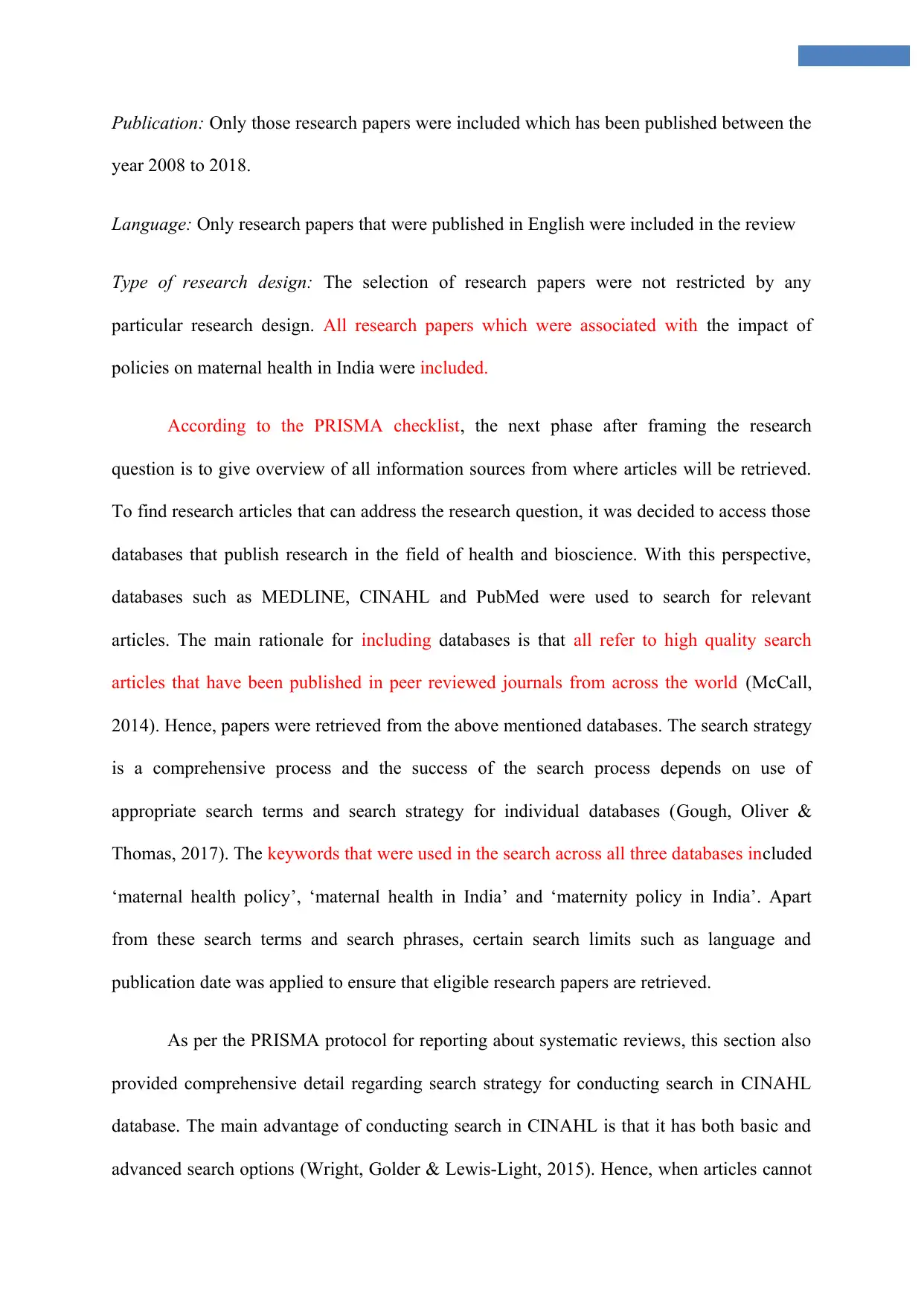
Publication: Only those research papers were included which has been published between the
year 2008 to 2018.
Language: Only research papers that were published in English were included in the review
Type of research design: The selection of research papers were not restricted by any
particular research design. All research papers which were associated with the impact of
policies on maternal health in India were included.
According to the PRISMA checklist, the next phase after framing the research
question is to give overview of all information sources from where articles will be retrieved.
To find research articles that can address the research question, it was decided to access those
databases that publish research in the field of health and bioscience. With this perspective,
databases such as MEDLINE, CINAHL and PubMed were used to search for relevant
articles. The main rationale for including databases is that all refer to high quality search
articles that have been published in peer reviewed journals from across the world (McCall,
2014). Hence, papers were retrieved from the above mentioned databases. The search strategy
is a comprehensive process and the success of the search process depends on use of
appropriate search terms and search strategy for individual databases (Gough, Oliver &
Thomas, 2017). The keywords that were used in the search across all three databases included
‘maternal health policy’, ‘maternal health in India’ and ‘maternity policy in India’. Apart
from these search terms and search phrases, certain search limits such as language and
publication date was applied to ensure that eligible research papers are retrieved.
As per the PRISMA protocol for reporting about systematic reviews, this section also
provided comprehensive detail regarding search strategy for conducting search in CINAHL
database. The main advantage of conducting search in CINAHL is that it has both basic and
advanced search options (Wright, Golder & Lewis-Light, 2015). Hence, when articles cannot
year 2008 to 2018.
Language: Only research papers that were published in English were included in the review
Type of research design: The selection of research papers were not restricted by any
particular research design. All research papers which were associated with the impact of
policies on maternal health in India were included.
According to the PRISMA checklist, the next phase after framing the research
question is to give overview of all information sources from where articles will be retrieved.
To find research articles that can address the research question, it was decided to access those
databases that publish research in the field of health and bioscience. With this perspective,
databases such as MEDLINE, CINAHL and PubMed were used to search for relevant
articles. The main rationale for including databases is that all refer to high quality search
articles that have been published in peer reviewed journals from across the world (McCall,
2014). Hence, papers were retrieved from the above mentioned databases. The search strategy
is a comprehensive process and the success of the search process depends on use of
appropriate search terms and search strategy for individual databases (Gough, Oliver &
Thomas, 2017). The keywords that were used in the search across all three databases included
‘maternal health policy’, ‘maternal health in India’ and ‘maternity policy in India’. Apart
from these search terms and search phrases, certain search limits such as language and
publication date was applied to ensure that eligible research papers are retrieved.
As per the PRISMA protocol for reporting about systematic reviews, this section also
provided comprehensive detail regarding search strategy for conducting search in CINAHL
database. The main advantage of conducting search in CINAHL is that it has both basic and
advanced search options (Wright, Golder & Lewis-Light, 2015). Hence, when articles cannot
⊘ This is a preview!⊘
Do you want full access?
Subscribe today to unlock all pages.

Trusted by 1+ million students worldwide
1 out of 43
Related Documents
Your All-in-One AI-Powered Toolkit for Academic Success.
+13062052269
info@desklib.com
Available 24*7 on WhatsApp / Email
![[object Object]](/_next/static/media/star-bottom.7253800d.svg)
Unlock your academic potential
Copyright © 2020–2025 A2Z Services. All Rights Reserved. Developed and managed by ZUCOL.





